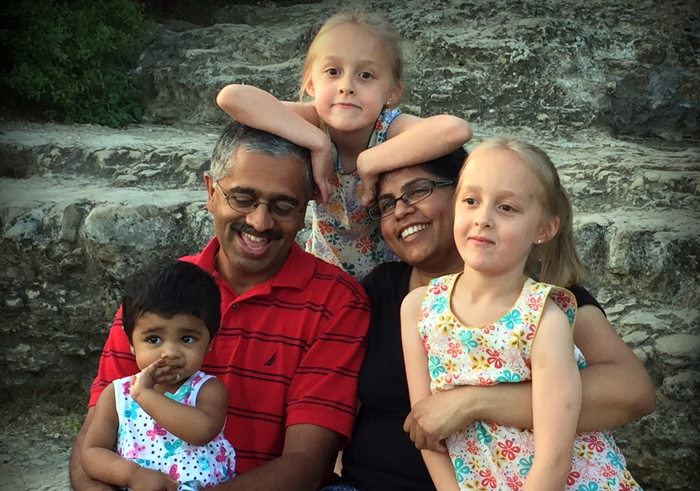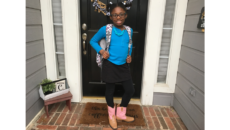“Scarlett eats meat!” M’s eyes are round, her tone incredulous. Before I can respond she adds, “We are vegetarian. We do not eat meat.”
I look at her, at a loss for words. I am not sure what I am supposed to say. “Does it bother you that we do not eat meat?” I ask. She ponders my question and goes off on a tangent. I let it be, making a mental note to revisit this conversation another time.
We are in the shower and I oil her scalp. Her skin glistens under the overhead lamp and I find myself awash with a love so strong that I am overwhelmed. I massage her tiny arms and legs and ask her to step aside while I do the same with her twin, A. We talk about school and I bring up our earlier conversation. We talk about beliefs, we talk about life choices, we talk about boundaries and we talk about respecting individual choices. I tell her that it is OK for her friend, Scarlett, to eat meat just as it is OK for her to not eat it. Both are valid choices I insist. She seems to understand and we switch gears and talk about what they did during recess.
[Free Webinar: Growing Up as a Transracial Adoptee: What Parents Need to Know]
I am at the stove focusing on a rapidly thickening mass of jaggery, coconut, and cardamom. The scent is heady and I am transported back to my childhood, watching my Amma shape rice dough into cups, fill them with balls of coconut and jaggery, and steam the dumplings on the gas stove. I feel a tug at my sleeve and notice A standing on tiptoe watching me. I make space and she slides next to me. I talk to her about Ganesha’s birthday. I talk to her about food. I talk to her about customs. She listens, rarely asking questions.
We are on the sofa reading a book and, out of the blue, she asks, “Am I Indian?” I ponder the question and tell her she is. At least a part of her is. She goes back to the book but my head is awash in questions. I am tempted to pull her to me, to explain that she is American by birth, Native American by birth heritage, and Indian by virtue of being raised by us. I let it be, knowing the next few years will feature more questions than answers. I savor the quiet and run my fingers through her fine, blond hair. She looks up, smiles, and rests her face against my shoulder.
I am reading a book on my phone, the tiny script beginning to irritate my eyes. I am tempted to lock myself in the study and read on the bigger screen of my Mac. I eye the girls sprawled out on the floor, the ceiling fan whirring overhead and I stay. My eye catches a part of the drawing lying at my feet. I edge forward and pick it up. There are five stick figures. Two with yellow hair, three with black. They all are smiling. I click a picture of the drawing on my phone and put the paper away.
Redefining Our Family’s Culture
We don’t talk much about race or color but it insinuates itself into our lives in tiny ways. In stick figure drawings. In the sunblock that I now pack for any trip outside. In my conscious effort to include diversity in my circle of friends. In my seeking out and establishing relationships with people touched by adoption, especially ones that cross racial borders. In seeking out literature and toys that feature light and dark skin, stories set in cultures worldwide, and in the foods I pack for lunch. It would be easy for me to cave in and pack what most other kids bring to school, but I don’t. I pack idlis and kuzhiappams, pulav and coconut rice, chapatis and potato curry. I persist even when lunch boxes come back untouched.
[How Will We Teach Our Child About Her Culture?]
In ways that I had not foreseen, our family is now a poster family for racial awareness. Our children are advocates for recognizing white privilege. Our interaction with the outside world is fraught with undertones. Regular grocery trips turn into adoption education. Checkout lines are trial runs to prepare my children for the harsh glare of the real world.
“Are they yours?”
“Where are their parents?”
“Are you their nanny?”
“What are they?”
My answers to these questions define me to my children. Am I protective of their history? Am I teaching them to guard their personal space? Am I teaching them to stand up for themselves? Am I showing deference to their birth families?
Five years after my twins came home, I found myself pregnant and dealing with overwhelming emotions. Happiness at something that I craved most of my married life. Fear of what it would mean to the children I was parenting. After S was born and I gathered all of my children together, I breathed a sigh of relief knowing I felt pretty much the same way about all three.
As I watch the three of them play and run unfettered through the house, I realize we will be redefining conventional explanations of what it means to be Indian or American. The hyphen will define us more than the terms themselves. As a family we will retain some traditions, invent new ones, and adopt a few more along the way. Our home will be lit up from Deepavali to Christmas. We will hang a wreath, set out Halloween candy, hang up ornaments, and rush to the temple on New Year’s Day.
My children will walk into interviews and challenge assumptions made based on their names. They will walk the streets of Chennai and speak Tamil with consummate ease. They will know how to make dosas, and how to bake a mean banana bread. My children will bridge cultures and define themselves all over again as adults.
Meanwhile, as a mother, all I can do is enable them to own their birth and adopted heritage with pride.



